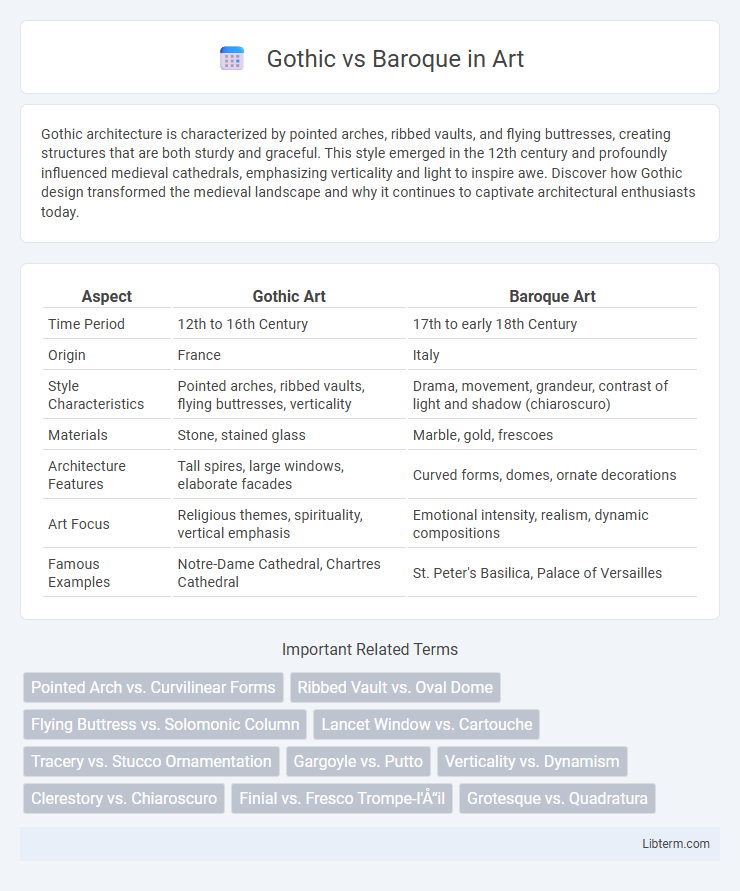Gothic architecture is characterized by pointed arches, ribbed vaults, and flying buttresses, creating structures that are both sturdy and graceful. This style emerged in the 12th century and profoundly influenced medieval cathedrals, emphasizing verticality and light to inspire awe. Discover how Gothic design transformed the medieval landscape and why it continues to captivate architectural enthusiasts today.
Table of Comparison
| Aspect | Gothic Art | Baroque Art |
|---|---|---|
| Time Period | 12th to 16th Century | 17th to early 18th Century |
| Origin | France | Italy |
| Style Characteristics | Pointed arches, ribbed vaults, flying buttresses, verticality | Drama, movement, grandeur, contrast of light and shadow (chiaroscuro) |
| Materials | Stone, stained glass | Marble, gold, frescoes |
| Architecture Features | Tall spires, large windows, elaborate facades | Curved forms, domes, ornate decorations |
| Art Focus | Religious themes, spirituality, vertical emphasis | Emotional intensity, realism, dynamic compositions |
| Famous Examples | Notre-Dame Cathedral, Chartres Cathedral | St. Peter's Basilica, Palace of Versailles |
Introduction to Gothic and Baroque Styles
Gothic architecture, originating in 12th-century France, is characterized by pointed arches, ribbed vaults, and flying buttresses that create soaring, light-filled spaces. Baroque style, emerging in the 17th century, emphasizes grandeur, dynamic movement, and dramatic use of light and shadow with elaborate decorations and intricate details. Both styles profoundly influenced European art and architecture, reflecting distinct cultural and religious shifts of their respective eras.
Historical Origins and Development
Gothic architecture emerged in 12th-century France, characterized by pointed arches, ribbed vaults, and flying buttresses that allowed buildings to soar vertically and fill interiors with light. Baroque architecture developed in the early 17th century in Italy as a dramatic evolution of Renaissance styles, emphasizing grandeur, dynamic movement, and elaborate ornamentation to evoke emotional responses. The Gothic style primarily served religious purposes during the Middle Ages, while Baroque architecture reflected the power of the Catholic Church and European monarchies during the Counter-Reformation and absolutist periods.
Key Architectural Features
Gothic architecture is characterized by pointed arches, ribbed vaults, and flying buttresses that allow for taller structures and large stained glass windows, creating an impression of verticality and light. Baroque architecture emphasizes grandeur and drama with curved forms, elaborate ornamentation, and dynamic shapes such as oval domes, bold columns, and intricate frescoes that create a sense of movement and emotional intensity. Both styles employ distinct structural innovations, with Gothic focusing on height and light, while Baroque focuses on ornate detail and theatrical spatial effects.
Artistic Elements and Aesthetic Principles
Gothic art emphasizes verticality, pointed arches, and intricate stained glass windows, creating a sense of lightness and spiritual elevation through detailed ornamentation and elongated figures. Baroque art features dynamic movement, dramatic contrasts of light and shadow (chiaroscuro), and rich, exuberant decorations that evoke emotion and grandeur. Both styles prioritize elaborate aesthetics, but Gothic art highlights spirituality and height, while Baroque art emphasizes theatricality and emotional intensity.
Religious and Cultural Influences
Gothic architecture, emerging in the 12th century, is deeply rooted in Christian spirituality, emphasizing verticality and light to symbolize divine presence, as seen in cathedrals like Notre-Dame de Paris. Baroque style, flourishing in the 17th century, reflects the Counter-Reformation's goal to inspire faith through emotional intensity, dramatic contrasts, and ornate details, exemplified by St. Peter's Basilica in Vatican City. Both styles profoundly shaped religious art and cultural identity, with Gothic fostering communal worship experiences and Baroque promoting theatricality and personal devotion.
Notable Examples Around the World
The Gothic architecture is exemplified by iconic structures such as Notre-Dame Cathedral in Paris, Chartres Cathedral in France, and Cologne Cathedral in Germany, known for their pointed arches, ribbed vaults, and flying buttresses. Baroque architecture, characterized by dramatic use of light, bold ornamentation, and grandeur, is showcased in buildings like St. Peter's Basilica in Vatican City, the Palace of Versailles in France, and the Church of San Carlo alle Quattro Fontane in Rome. These masterpieces reflect the distinct artistic and cultural priorities of their respective eras, demonstrating the transition from the medieval to the early modern period in European architectural history.
Differences in Interior Design
Gothic interior design features pointed arches, ribbed vaults, and stained glass windows that create a vertical, light-filled atmosphere emphasizing height and spirituality. Baroque interiors contrast with elaborate ornamentation, curved forms, rich colors, and dramatic use of light and shadow to evoke emotion and grandeur. The Gothic style emphasizes structural clarity and minimal decoration, while Baroque embraces opulence and theatricality.
Influence on Modern Architecture
Gothic architecture's emphasis on verticality and light through pointed arches and ribbed vaults has inspired modern skyscraper designs and structural innovations in materials like steel and glass. Baroque architecture's dynamic shapes, dramatic use of space, and ornamental details influence contemporary public buildings and cultural institutions seeking to evoke grandeur and emotional impact. Both styles contribute to modern architecture by integrating historical aesthetics with advanced engineering techniques.
Public Perception and Legacy
Gothic architecture is perceived as a symbol of medieval spirituality and mystery, marked by soaring cathedrals and intricate stonework that evoke awe and reverence. Baroque architecture, celebrated for its grandeur and dramatic ornamentation, is associated with the power and opulence of the Counter-Reformation era, leaving a legacy of richly decorated churches and palaces. Public perception favors Gothic's verticality and light-filled spaces as timeless spiritual experiences, while Baroque's dynamic forms and emotional intensity continue to influence modern art and architecture.
Gothic vs Baroque: A Comparative Summary
Gothic architecture, characterized by pointed arches, ribbed vaults, and flying buttresses, emphasizes verticality and light with intricate stained glass windows creating a sense of spiritual elevation. Baroque architecture contrasts with its dramatic use of curves, elaborate decorations, and dynamic forms aimed at evoking emotion and grandeur through bold contrasts of light and shadow. While Gothic style reflects medieval religious aspirations and structural innovations, Baroque represents the 17th-century shift towards theatricality and ornamentation in both churches and palaces.
Gothic Infographic

 libterm.com
libterm.com